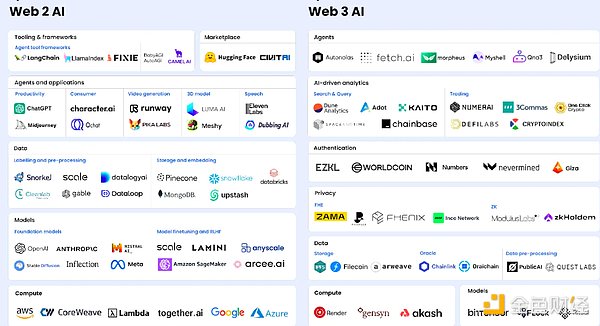Author: FLock.io; Translation: 0xjs@金财经
We are entering a decisive era in the development of AI, in which generative AI and The convergence of blockchain is opening up new frontiers in digital innovation.
We dive deep into this paradigm shift, charting the journey from the established centralized AI framework of Web2 to the decentralized innovation of Web3.
Web2 AI and Web3 AI stack and track projects

Fundamentals: Web2’s AI Technology Stack
The AI landscape in the Web2 era can best be understood through a layered approach, each representing artificial intelligence A key aspect of intelligent development and deployment. This breakdown provides a clearer view of how individual components interact and contribute to the overall AI ecosystem. These layers include:
Compute Engine
At the core of AI capabilities are centralized cloud services such as AWS and Azure. These platforms are the cornerstone of AI operations, providing the computing power necessary to analyze complex data and perform machine learning tasks at scale.
Basic Model
Centralized model training platforms represented by entities such as OpenAI and Anthropic have played a crucial role in the democratization of artificial intelligence . These platforms make advanced AI capabilities available, triggering a widespread proliferation of AI applications in various fields.
Data Management
The efficiency of AI in Web2 relies heavily on effective data management systems. Tools like Scale AI and Mechanical Turk simplify data preprocessing to ensure it is ready for analysis. Meanwhile, platforms such as Pinecone, Databricks and Snowflake play a key role in managing and storing massive data sets, thereby facilitating easy access and action.
Agents and Applications
The versatility of AI in Web2 is evident in its wide range of applications. From marketing tools like Jasper and copy.ai to groundbreaking innovations in healthcare enabled by Glass, the applicability of AI spans multiple sectors, demonstrating its transformative potential.
Tools and Frameworks
This layer has greatly shaped artificial intelligence development in the Web2 era, with basic tools and frameworks for artificial intelligence agent development , such as Langchain and LlamaIndex. Platforms such as BabyAGI, AutoAGI and Camel are critical to enhancing agent development, providing specialized environments for creation and refinement. Collectively, these elements enrich the sophistication and advanced capabilities of AI agents and mark a key advancement in AI capabilities during this period.
Market mechanisms
The emergence of platforms such as HuggingFace and GitHub has fostered a collaborative ecosystem that allows the sharing and discovery of AI models and tools.
Evolution: Web3’s decentralized AI framework
With the transition to Web3, our exploration of AI has entered a new dimension. Building on Web2’s layered approach, we take a deeper look and illustrate how decentralization and blockchain are redefining AI projects. The unique properties of Web3 require additional layers, specifically privacy and authentication, demonstrating how these transformative technologies can foster more secure, transparent, and collaborative AI environments. This nuanced approach reveals the profound impact decentralization will have on the development of artificial intelligence, paving the way for a future where trust, ownership, and innovation thrive.
Computing Collaboration
Blockchain technology is revolutionizing computing collaboration, moving from centralized cloud services such as AWS to a decentralized global resource network. Projects like Render, Akash, and Gensyn demonstrate this evolution, enabling participants to contribute computing power and foster a more inclusive ecosystem.
Model development
Unlike centralized platforms such as OpenAI that dominate Web2, Web3 is embracing decentralized model building. This new approach, exemplified by the Bittensor Network, promotes the collective contribution of a global community.
Data democratization
Web3 rewrites the rules. No more data is locked away in corporate vaults. Instead, imagine a vibrant community collaborating to annotate data to conduct breakthrough research, from medical analysis to self-driving car training. Tools like IPFS and Filecoin ensure secure distributed storage, allowing individuals to control their own data and be rewarded for their contributions. It’s not just data – it’s a new social contract about ownership, collaboration and shared progress.
Data Privacy
Blockchain becomes a shield for your information. Imagine training artificial intelligence on sensitive medical data without exposing patient identities, with the help of advanced encryption and zero-knowledge proofs. Companies like Privasea and Modulus Labs are leading the way in shifting the paradigm from intrusive, centralized models to privacy-first AI. This is the promise of Web3: AI that learns and grows while keeping your data safe and under your control.
Authentication
Solutions like EZKL and Worldcoin provide secure, self-sovereign identity management without the need for a centralized platform to hold your login credentials. Imagine being able to log into an AI application without having to rely on Facebook or Google, increasing security and putting you in control of your digital identity.
AI-driven analytics
Platforms like Dune Analytics and NumerAI leverage cutting-edge AI algorithms to transform data analysis in Web3. Imagine seamlessly exploring complex DeFi protocols, identifying investment opportunities, and making informed decisions, all powered by AI in a transparent and community-driven ecosystem.
Agents
Web3 supports the development of agents like Autonolas and Fetch.ai that can navigate decentralized networks and perform tasks autonomously on your behalf. Imagine AI agents managing your investments, negotiating decentralized exchanges, or optimizing your resource allocation across Web3 protocols, ushering in a new era of automated and personalized services.
Final Thoughts
The synergy of blockchain and AI in the Web3 space heralds a new era of innovation that combines the advantages of blockchain in data ownership, transparency and ethical governance Combined with the advanced capabilities of AI. This integration paves the way for enhanced data ownership, greater transparency in AI systems, and facilitates direct data monetization. It also commits to minimizing AI’s energy footprint and promoting ethical AI development.
 JinseFinance
JinseFinance
 JinseFinance
JinseFinance JinseFinance
JinseFinance JinseFinance
JinseFinance JinseFinance
JinseFinance JinseFinance
JinseFinance JinseFinance
JinseFinance JinseFinance
JinseFinance JinseFinance
JinseFinance Catherine
Catherine Bitcoinist
Bitcoinist